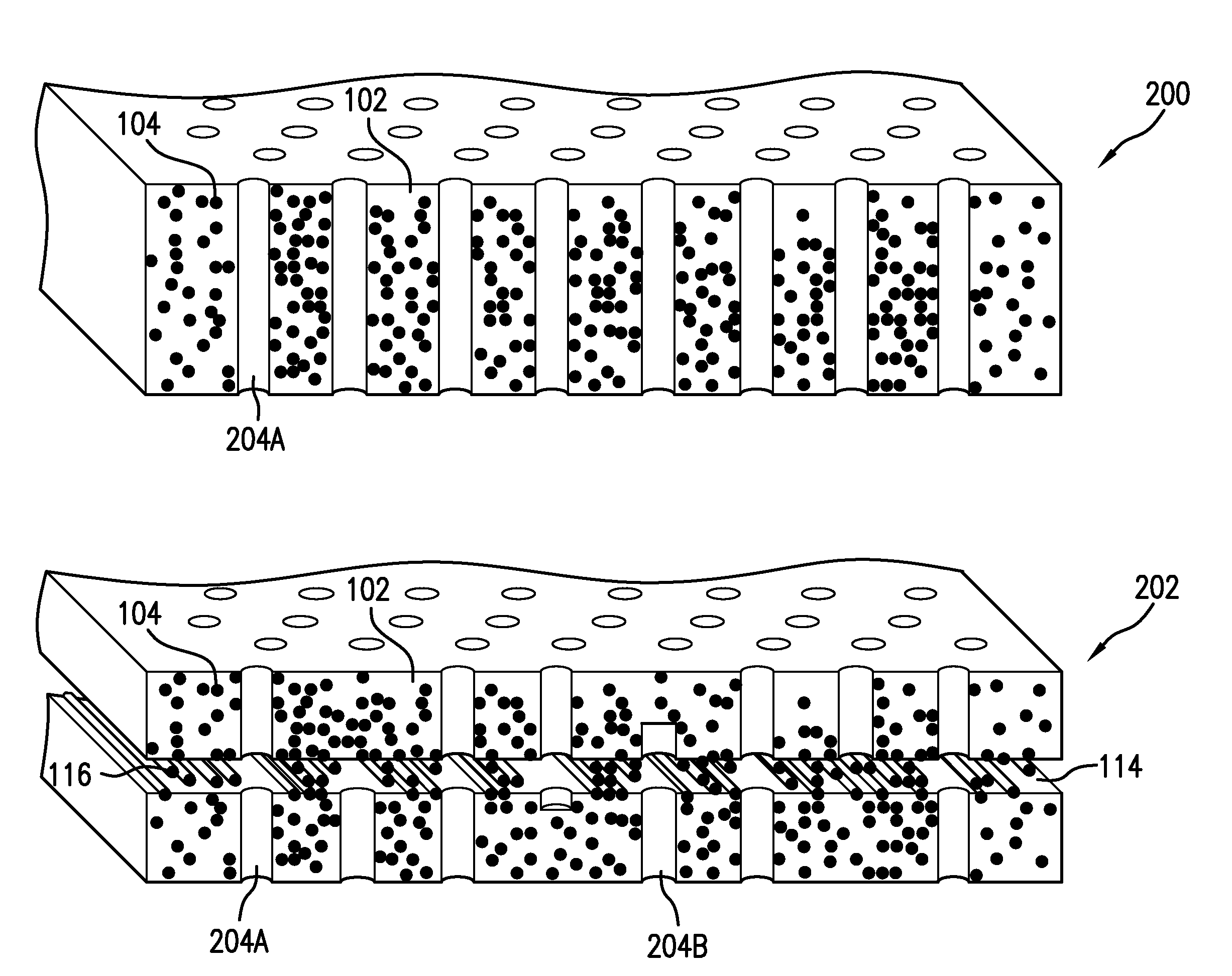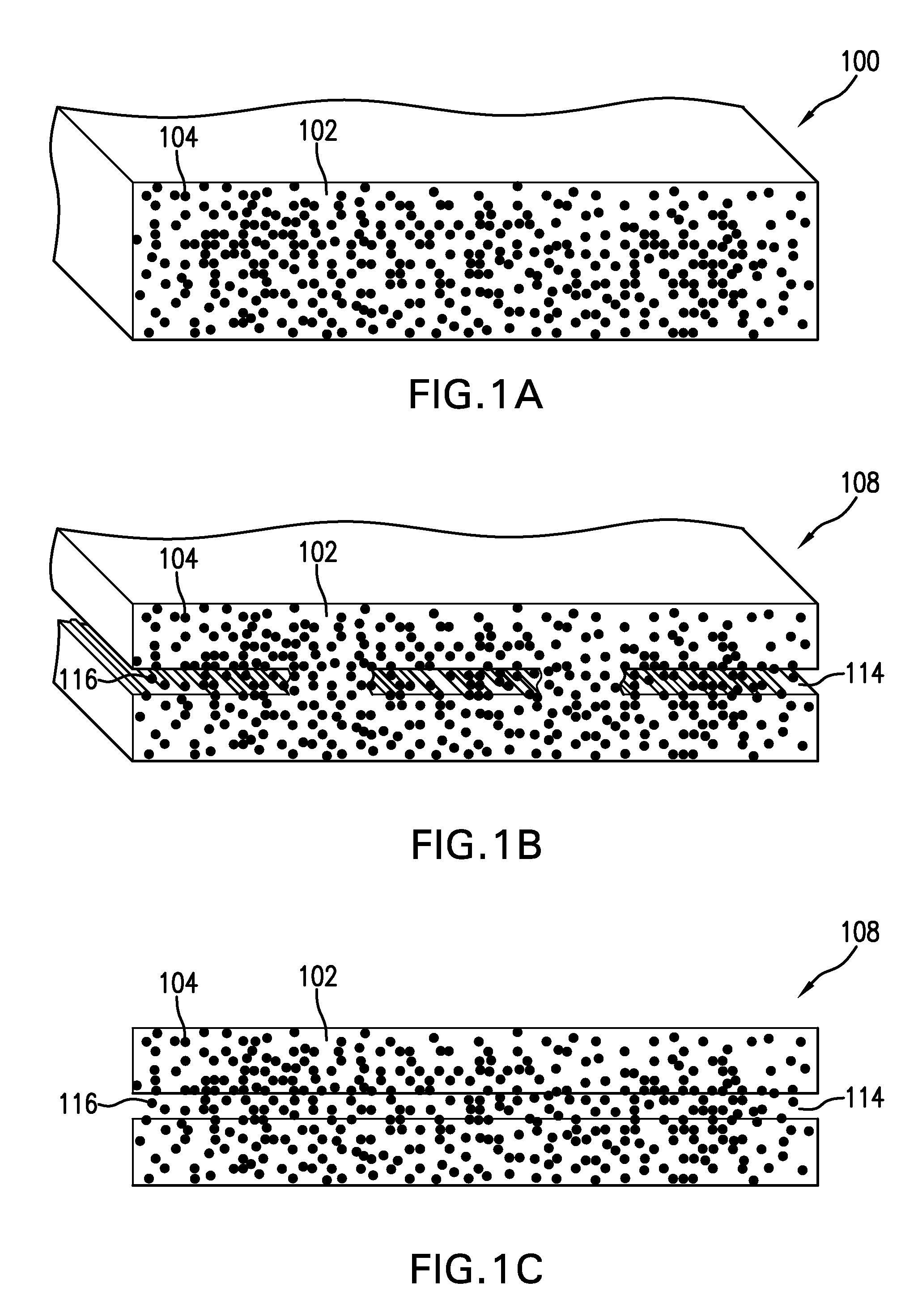Prepregs with improved processing
a technology of pre-pregs and processing, applied in the field of pre-impregnated fibers, can solve the problems of difficult removal, difficult consolidation of pre-pregs to form composites in this manner, and increase the difficulty of removal, so as to improve the removal ability
- Summary
- Abstract
- Description
- Claims
- Application Information
AI Technical Summary
Benefits of technology
Problems solved by technology
Method used
Image
Examples
example 1
Summary
[0077]
TABLE 1Summary of Example 1MatrixPorosityPartialFractionEdge(volumeTrialMatrixFiberImpregnation(wt. %)PerforationsBreathing%)1CycomT40 / 800Yes35NoYesless5215than0.12CycomT40 / 800Yes35NoNo5.552153CycomT40 / 800Yes35YesNoless5215than0.1
[0078]The data of Table 1 show that the use of edge breathing, when fabricating non-perforated prepreg layups using vacuum pressure only, enabled a significant reduction in the porosity of the composite, from about 5.5 vol. % to less than about 0.1 vol. %. It was further observed that a similar reduction in the composite porosity could be achieved through the use of perforated prepregs, without the need for edge breathing.
Example 2
Carbon Fiber / Epoxy Composites Fabricated from Partially Impregnated Prepregs Using Autoclave Pressure and Vacuum
[0079]Three carbon fiber / epoxy composites, trials 4, 5, and 6, were fabricated from partially impregnated prepregs with vacuum and autoclave pressure. Edge breathing and the presence and absence of perforat...
example 2
Summary
[0083]
TABLE 2Summary of Example 2PartialMatrixPorosityImpreg-FractionPerfo-Edges(volumeTrialMatrixFibernation(vol. %)rationsSealed%)4CycomHTSYes34NoNoless977-2than 0.15CycomHTSYes34NoYesgreater977-2than 56CycomHTSYes34YesYesless977-2than 0.1
[0084]The data in Summary Table 2, show that the use of edge breather when fabricating non-perforated prepreg layups using vacuum and autoclave pressure enables a significant reduction in the porosity of the composite, from about 5 vol. % to less than about 0.1 vol. %. The data further shows that a similar reduction in the composite porosity could be achieved through the use of perforated prepregs, without the need for edge breathing.
example 3
Carbon Fiber / Epoxy Composites Fabricated from Fully Impregnated Prepregs with Vacuum Bag Only (VBO) Conditions in an Oven
[0085]Two carbon fiber / epoxy composites, trials 7 and 8, were fabricated from substantially fully impregnated prepregs. It was observed that, in composites fabricated with vacuum pressure only from fully impregnated, perforated prepregs, exhibit lower porosity than composites consolidated under substantially identical conditions from prepregs without perforations.
Trial 7—Non-Perforated Fully Impregnated Prepregs Without Edge Breathing
[0086]The carbon fiber / epoxy composite of Trial 7 was fabricated from unidirectional prepregs comprising Thornel® T40 / 800 having an areal fiber weight of about 145 g / m2. The matrix, comprising CYCOM® 5215 epoxy resin, was substantially fully impregnated and the matrix weight fraction of the prepreg was approximately 35 vol. %. The prepreg was impregnated at a temperature of about 105° C., at approximately 1 meter / min speed and using ...
PUM
| Property | Measurement | Unit |
|---|---|---|
| Diameter | aaaaa | aaaaa |
| Diameter | aaaaa | aaaaa |
| Area | aaaaa | aaaaa |
Abstract
Description
Claims
Application Information
 Login to View More
Login to View More - R&D
- Intellectual Property
- Life Sciences
- Materials
- Tech Scout
- Unparalleled Data Quality
- Higher Quality Content
- 60% Fewer Hallucinations
Browse by: Latest US Patents, China's latest patents, Technical Efficacy Thesaurus, Application Domain, Technology Topic, Popular Technical Reports.
© 2025 PatSnap. All rights reserved.Legal|Privacy policy|Modern Slavery Act Transparency Statement|Sitemap|About US| Contact US: help@patsnap.com



